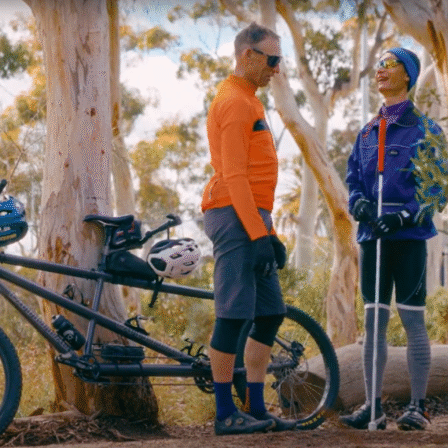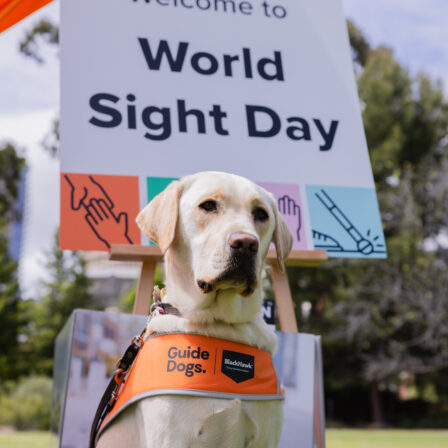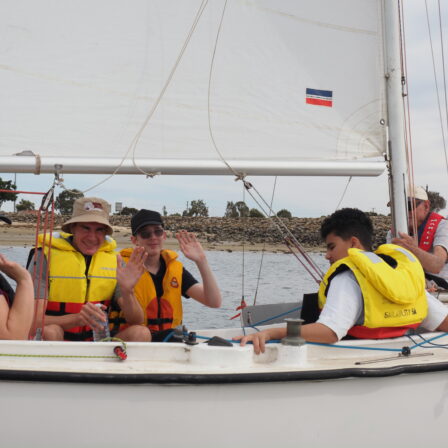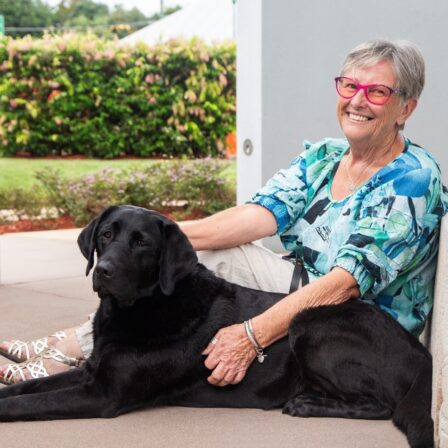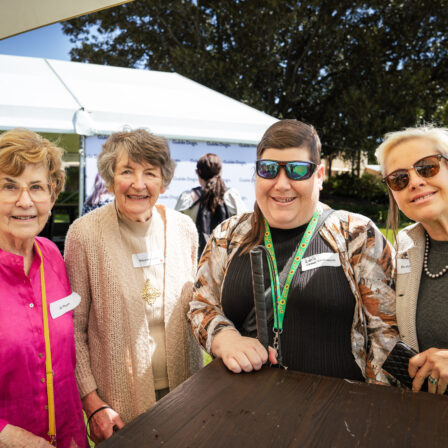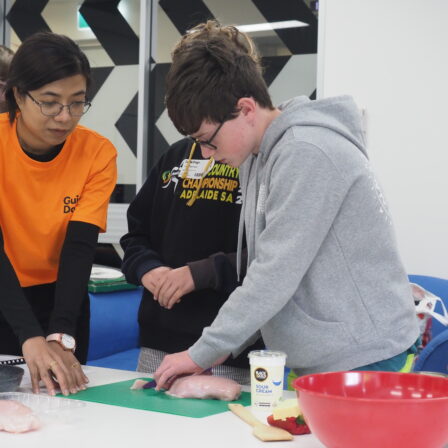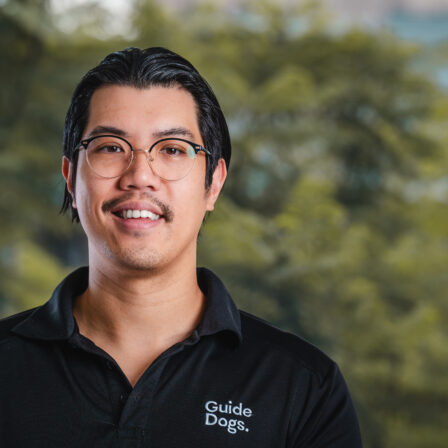News
60 things you didn’t know about Guide Dogs
It’s the last few days of our 60th Year! We hope you have enjoyed our journey of photographs from years gone by throughout 2017.
As we wrap up the Diamond Jubilee, Guide Dogs SA/NT says thank you to everyone who makes up the Guide Dogs family – our early pioneers, supporters, donors, staff, volunteers, and of course our clients. You make us what we are.
We are proud of our history and tradition. Over the past 60 years we’ve been innovative and passionate about changing the lives of people living with sensory loss. We aim to continue that tradition well into the future.
To wrap up the diamond jubilee year here’s a reminder of the 60 things you didn’t know about Guide Dogs.
1. The Guide Dogs movement started after World War 1 in Germany to assist blinded soldiers returning from the battlefields. Something amazing arising from such a tragedy!
2. The first person to bring a Guide Dog to Australia was Arnold Cook. He had been studying at university in England and witnessed the amazing program. On return to Perth with his Guide Dog Dreena he created a sensation and the first Guide Dog Association was formed in WA in 1951. Humble beginings, it was housed in two old tram carriages.
3. The first officially trained Guide Dog in Australia was Beau, a kelpie/fox terrier cross, who became famous around the country with his handler Elsie Mead during their tours to every State to gain support for the Guide Dog movement. He was more than14 years old when cataracts on both eyes and arthritis caused his retirement. He lived a contented, snoozy late life and died a few days before his 17th birthday.
4. Our social enterprise Beau’s Pet Hotel near the Adelaide Airport is named after this pioneer dog. Through Beaus we are looking towards the future.
5. Interest spread around Australia and in 1957 the Guide Dogs SA Association was started by the Adelaide and Unley Apex Groups. In that year there were now Guide Dogs Associations in every State.
6. The first qualified Guide Dog in South Australia was Faye who was placed with Miss L Ewert in Brighton in 1957 after training interstate.
7. Renmark was the first region in country South Australia to have a Guide Dog placed in 1962.
8. In 1962, the first specially-designed Guide Dog Centre in the world was built on land at Kew in Victoria. the land was granted to the National Association by the Victorian Government. South Australia was instrumental in the raising of funds to build the National Centre with a a memorial fund in honour of local radio star Jack Davies who was a strong Guide Dogs supporter. The centre was opened by then Prime Minister Sir Robert Menzies on 17th November 1962.
9. In the early days dogs were offered by donation for Guide Dog training. From the first 130 dogs offered, 11 were selected for further training and were transported to Melbourne by Ansett-ANA to be formally trained at the Kew Training Centre. Guide Dogs are now specifically bred and raised for their important roles.
10. All puppies born in the same litter are named with the same letter of the alphabet. eg. Boston, Bentley, Buster, Belle, Biscuit, Bliss. Then the next litter will have names beginning with C and so on.
11. Guide Dog puppies don’t have common human names – that’s so when someone calls out a name in public etc, they are not distracted from their work and think someone is calling out to them.
12. In the 1960s airline Ansett-ANA made their parked aircraft available to the National Training Centre for Guide Dog familiarisation. Hosties trained on evacuating people travelling with a Guide Dog and also experienced under blindfold the challenges of eating an airline meal in flight.
13. Booties! Our puppies and Guide Dogs don’t work when it is 32C or over and their handlers use their white canes. But if the dogs are going in an airconditioned car to an airconditioned office they have little booties to protect from hot pavements. They also wear the booties if they have sensitive feet.
14. The Guide Dog breeding programme favours yellow and black Labradors as the most suitable coloured dogs – Labradors have the most suitable nature, are eager to learn and please and with the aid of a selective breeding programme have the physique required for their job ahead.
15. Guide Dogs are working when they have their harness or coat on and should not be distracted by people patting or calling out to them. When their “work wear” is off they can play, interact and have fun in a normal doggy way!
16. A local dog breeding and training programme was launched in SA in 1998. Big hearted South Australians give the gift of their time to puppy raise little Guide Dogs before they go into formal training.
17. We became #morethandogs in 1965 with all associations taking up the South Australian idea to embrace the latest aids such as white canes, sonic equipment etc. to enhance independence for people with vision loss as well as providing Guide Dogs.
18. The iconic Channel 9 Telethon benefitted Guide Dogs from the 1968 telecast. Thank you to all the Miss Telethons and people who donated.
19. Guide Dogs are provided free of charge to the recipient and veterinary care is provided for their working life, thanks to the generosity of community donations and philanthropy.
20. Guide Dogs can go anywhere under legal access rights. But there are three exceptions, they can’t go to a zoo for quarantine reasons, operating theatres and burns units in hospitals. In 1966 the SA Government passed amendments to the Registration of Dogs Act giving access to Guide Dogs when accompanying their owners. Penalities could then be imposed on anyone who refused entry or carriage.
21. Guide Dogs are trained to move in a straight line, and go around any obstacles in the way. They will stop at stairs, doors and kerbs but will wait for a command from their handler for where to go and when to move. They are not a GPS and directional clues come from the handler.
22. While obeying instructions from their handler, Guide Dogs are taught “intelligent disobedience” if their handler will be placed in danger. There are wonderful anecdotes from our history about Guide Dogs saving their handlers from falling into a hole.
23. Perfect match. Each Guide Dog and handler are matched so they become a cohesive team. Walking pace, work environment, height, age, lifestyle, other pets, family situation are all taken into account before the pair graduate.
24. Guide Dogs SA is accredited by the International Guide Dog Federation and meets and exceeds requirements as defined in the Accreditation Standards, which are reviewed annually.
25. You don’t have to have lost all your vision to qualify for a Guide Dog. Many Guide Dog handlers have some residual vision.
26. Volunteer Puppy Raisers care for puppies aged from 8-10 weeks in their own homes for a minimum of a year and get to do fun things like taking them to shops, cafes, the beach and on public transport to socialise them into their potential working world.
27. Puppy Raisers give the gift of their love and time in raising a puppy. As all food, training, equipment and vet visits are supplied free of charge thanks to the generosity of the community.
28. If a Puppy Raiser or Guide Dog handler needs to go away on a holiday cruise or spend some time in hospital a network of short term boarders are available to look after the dogs for as long a needed.
29. Guide Dogs are trained to protect their handler by making allowances for height and width and in that way protect their right shoulder, upper body and their heads on overhanging branches or low signs. However everyone can help by cutting back their garden tree branches and bushes so they don’t over hang the path. Putting bins away on bin day helps too.
30. It takes about two years to train a guide dog from birth. First the puppy must learn house training and obedience and become used to the outside world. About 14-16 months of age the puppy is assessed for on-going training which lasts about six months. About two years of age the Guide Dog is matched with a client and they train together for two to four weeks with regular follow ups throughout their partnership.
31. A Guide Dog puppy can’t be left alone for more than four hours.
32. South Australia has its own breeding centre and the puppies are born at Morphett Street. They stay their with mum in the Puppy Development Centre until they are about 8-10 weeks.
33. Young puppies in the Puppy Development Centre are played tapes of thunder and lightning and vehicle sounds so they get used to these and stay nice and calm if when they encounter these loud noises when they are out and about.
34. Not every puppy accepted into the program is suitable for taking on the role of a Guide Dog, given their strengths some have career changes. The puppies are assessed at eight weeks and again at about 14-16 months to assess their suitablility for a working role as a Guide Dog or Autism Assistance Dog. Both are separate streams of the program.
35. Dogs that aren’t suitable for becoming a Guide Dog or Autism Assistance Dog could be selected as a Therapy Dog.
36. Autism Assistance Dogs were introduced in 2010 after a two-year pilot.
37. Therapy Dogs (companion dogs for people with a disability) was introduced in 1989.
38. Pet & Retired dogs are available to be purchased as a family pet. There is a matching process for these and we only place our dogs in a home where they will have human companionship for most of the day and live and sleep inside as part of a family. These dogs are placed for a trial period to ensure a good fit for the home.
39. Through cooperation with other Guide Dog and Assistance dog organisations, we now have breeding stock either directly from or carrying the genetic lines of many leading schools from around the world, including New Zealand, the United States, the United Kingdom, Europe and Asia
40. On May 28th 1970 singing sensations John Farnham and Kamahl traveled to Adelaide to support The Fireman’s Ball at Centennial Hall raising funds for Guide Dogs. Their arrival stopped the town when big crowds turned out to greet them!
41. Guide Dogs SA has an in-house vet to oversee the breeding programmes and the health care of all our dogs to ensure they are in tip top condition at all stages of their life.
42. Guide Dogs SA has an Ambassadog named Lenny who makes public appearances and visits Corporate Sponsors. He’s following the big pawprints of adored former Ambassadogs Tango and Bella who led the way and are now enjoying retirement.
43. All puppies born at the Morphett Street Guide Dogs Puppy Development Centre are sent to their Puppy Raiser homes with two individually designed blankets made by Bev, one of our dedicated volunteers. Yes pink for the girls and blue for the boys. Dark colours for black dogs, lighter for the yellows. To date its more than 300 blankets – that’s a lot of love.
44. A Guide Dog’s diet is very strict to ensure tip top health and condition. It is based around a dry food allocation (Advance) with rewards coming from their daily food allowance. Favourite treats are apple slices and carrots. A Guide Dog needs to be fit and trim.
45. Thousands of people learnt about and experienced the challenges of vision loss through interactive displays at Guide Dogs SA’s award-winning Discovery Centre. The experience will now be evolved into a program in the community.
46. Guide Dogs not only guide, they provide a person with vision loss companionship, love, safety, independence and inclusion by opening up their ability to participate in their community, breaking down isolation.
47. Our iconic life-size model collection dogs can be found in shops and other businesses and there’s smaller ones for counters. They get plenty of cuddles and pats from little children. There’s 1,674 around the State. Commissioned in 1963, the first was placed in Norwood. Now you’ll find them all over the State north, south, east and west from Leigh Creek and Port Augusta, Mount Gambier, Ceduna and Kangaroo Island. Little coins make a big difference. We are now also going high tech too, with tap to donate electronic machines appearing this year in shops and cafes.
48. Blind SA teacher Miss Ruby Belleli was the second person to receive a Guide Dog provided by the SA Association and was the first blind person in Australia to be granted registration as a secondary school teacher.
49. The early pioneers who developed Guide Dogs SA have meeting rooms in Morphett Street named after them to pay tribute to their outstanding contributions – Frank Beauchamp, Bevan Rutt, Malcolm Penn. We also have rooms named after Beau, Irene Baxter, Beth Klugh, Roy and Marjorie Edwards, and the Johnston and Ness rooms paying tribute to major donors and bequesters and the Schembri room is named after Emanuel Schembri a community liaison officer who had Guide Dogs Ben and Kelti.
50. The late Malcolm Penn OAM was the first blind person to graduate in law from the University of Adelaide, and was accompanied by his first Guide Dog while on campus towards the end of his degree. Also a keen sportsman, Malcolm completed three Adelaide Marathons and several City-Bay fun runs with the assistance of sighted guides. He also took part in the Sydney Olympics Torch Relay with his Guide Dog Vinty.
51. Guide Dogs SA was pleased to assist the SA Ambulance Service in 2014 for dog safety restraints to be installed in South Australian ambulances to help paramedics cope with the increasing number of patients who rely on the help of canines.
52. Guide Dogs has been voted Australia’s Most Trusted Charity for the past five years in a row. We are humbled by your faith in our work.
53. International Guide Dog Day is held on the last Wednesday of April to celebrate the difference the amazing dogs make to people’s lives. In Adelaide there is a parade of suppawters and Guide Dogs down King William Street to Government House.
54. Ian Shepherd and Guide Dog Butch were the first in South Australia to be trained in 1969 the use of binaural spectacles at the national training centre. The spectacles enable a sense of the surrounding environment by means of ultrasonic waves which are converted to audible sounds.
55. Betty Bridges was the first Guide Dog trainer in Australia having met Arnold Cook in England during his training with his dog Dreena. In the 1940s she had applied for a position with Captain Laikoff who was training Guide Dogs in England, but was told only men were wanted. That all changed in World War II and she became one of his pupils.
56. In 1966 Maralyn Clark, 20, became the first blind person in South Australia to obtain a St John Ambulance First Aid Certificate. She topped the class in the final exam. She worked as a switchboard operator, was a member of the Adelaide Rural Youth Club and the owner of golden Labrador Guide Dog Panda.
57. Elsie Mead was presented with a British Empire Medal for services to Guide Dogs by Her Majesty Queen Elizabeth II during the Royal Visit to Perth in 1982. By then Elsie was accompanied by her Guide Dog Wendy.
58. In 1962 Northern Territory joined with South Australia for the organisation to become Guide Dogs SA/NT.
59. All Guide Dogs SA/NT Guide and Autism Assitance Dogs are provided with ongoing annual support visits to ensure that they are working optimally. This also ensures that we identify when the dog should retire which is at a time or stage that will ensure they have some quality of life in retirement, (this is by agreement). Retirement age is normally around 10/11years of age. This does fluctuate however depending on the type of work they have been asked to perform through working life.
60. Guide Dogs relies on the generosity of the community to be able to provide it’s services. There are many ways to contribute from regular donations, puppy sponsorship, hosting a collection dog or a community event.

